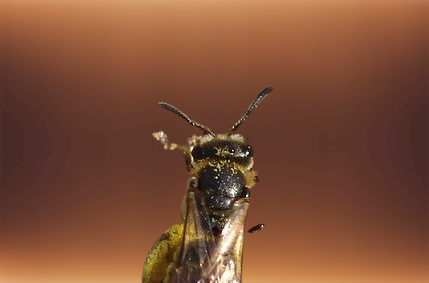The social honey bees that inhabit man-made hives or the cavities of hollow trees are very well known to the vast majority of people. There are other additional species of bees in the world that nest in the soil, hollow stems, wood, and other environments. These are largely indigenous insects that play a major role in pollination. There are more than 80 species of these wild bees that visit apple blossoms, 12 species that visit melons, and 20 species that visit tomatoes. It’s not uncommon for these bees to be more effective pollinators than honey bees, and as a result, the pollination impact of even a small number of bees nesting in the yard is often enormous.
Ground nesting bees are the type of bees that build underground galleries. Nests are often identified by the little heaps of earth or bare spots that serve as entrances. Although they don’t form colonies, multiple females often build their nests in the same place. The queens of ground bees do not guard their nesting grounds, are extremely docile and pose a very low risk of stinging people. As a result, ground bees provide a negligible or no hazard to people.
Ground Nesting Bees Identification and Size
The majority of species of ground-nesting bees are solitary, and their length mostly varies from 12 to 34 inches. They dig tunnels in the ground or through the wood. Depending on the species, they also appear in a wide range of colors, including green, blue, copper, and metallic reddish-brown. The ground bee’s nest resembles a series of little mounds of dry soil with a hole bored through the middle of each mound. Nests built by ground bees are typically only a few inches (2.5-5 cm) wide and an inch or two (2.5-5 cm) high. The central hole is about the size of a huge pencil.
Bees that nest in the ground can typically be recognized by their fuzzy, tan-colored heads, pair of wings that are translucent, the face that is shaped like a heart, two segmented antennae, and large complex eyes. Most of these bees are about 0.5 inches (13 mm) long, and they are active from March to July.
Ground bees include several distinguishing characteristics, one of which is their preference for resting in the sun. As a result, the ground bee’s nests are frequently discovered in sunny garden spots or on hills with an east or south orientation. The females frequently relax by sitting at the opening of the nest.
Ground Nesting Bees Sting
The term “ground nesting bee” refers to any species of bee that excavates underground tunnels to raise its offspring. Ground bees live independently, as opposed to honey bees, which are social insects that reside in big colonies and hives. They begin to buzz between flowers, consuming nectar and pollinating flowers, as soon as it starts to heat up in the spring.
Despite having a stinger, ground bees rarely harm humans. Normally, ground bees only sting people when they are provoked. Because of this, if people mess with bee nests or try to handle bees, they almost always end up getting stung at some point. The vast majority of the time, ground bees are peaceful and non-aggressive bugs.
Male ground bees, like other male bee species, lack stingers and cannot sting or bite people. A risk associated with ground bee stings, as with all bee stings, is an allergic reaction. So, if something bad happens after a bee sting, like swelling in the throat or tongue or a fast heartbeat, it’s best to go to the hospital right away.
Ground Nesting Control
There are several natural preventative measures and management strategies for eliminating ground-nesting bees without damaging the environment. Among them are the following:
- When attempting to exterminate ground-nesting bees, it is preferable not to use chemicals or pesticides. Using insecticides as a method of pest management is mostly dangerous for both humans and beneficial insects. Another issue is that garden pests often develop a tolerance to insecticides, rendering them useless.
- Blocking the entryway to the nest is the most effective method for eliminating ground bees from the garden. The next step is to cover the tunnel’s opening with dirt and a stone. This prevents the female from producing eggs and nurturing young.
- To assist in permanently getting rid of ground bees, make a non-toxic, homemade bee repellant. Peppermint is thought to be offensive to bees due to its strong scent. Additionally, natural repellents like cinnamon and cayenne pepper are also used.



